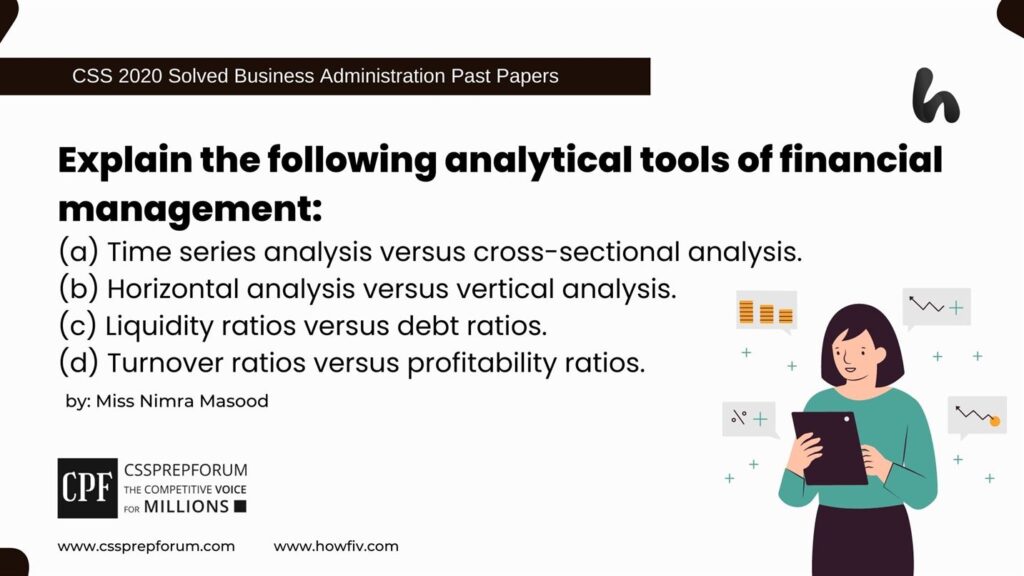(a) Time series analysis versus cross-sectional analysis.
(b) Horizontal analysis versus vertical analysis.
(c) Liquidity ratios versus debt ratios.
(d) Turnover ratios versus profitability ratios.
CSS Solved Business Administration Past Papers | Explain the following analytical tools of financial management: (a) Time series analysis versus cross sectional analysis. (b) Horizontal analysis versus vertical analysis. (c) Liquidity ratios versus debt ratios. (d) Turnover ratios versus profitability ratios.
The following question is attempted by Miss Nimra Masood, the top scorer in CSS Business Administration papers. Moreover, the answer is written on the same pattern, taught by Sir to his students, scoring the highest marks in compulsory subjects for years. This solved past paper question is uploaded to help aspirants understand how to crack a topic or question, how to write relevantly, what coherence is, and how to include and connect ideas, opinions, and suggestions to score the maximum.

Topic Breakdown:
Topic: Financial Analysis.
Subject: Financial Management.
Finance is one of the pillars of business administration; therefore, the CSS examiner gives two questions from this portion every year. A clear understanding of finance assists in not only this paper but also Accounting and Auditing.
Financial Management is one part of business management. It can be analyzed from various dimensions. Financial Analysis, Budgeting and Financial Statements are all important to understanding the gist of financial management. Students must prepare this part extensively to gain good marks in exams.
Introduction:
In this question, various ways will be analyzed in which, financial data can be analyzed. To get a comprehensive overview of the company’s financial standing, quantitative data must be analyzed from different perspectives.
(a) Time Series Analysis vs Cross-Sectional Analysis:
- Time Series Analysis:
This analysis is about observing a single variable over different periods of time. For example, analyzing the change in the company’s current assets quarterly is a time series analysis. This data should be discrete and spanned over an equal time period.
- Cross-Sectional Analysis:
A type of data that looks into the different companies at some point for any one variable. For example, analyzing the debt-to-equity ratio of each company working as competitors in the same environment.
(b) Vertical Analysis vs Horizontal Analysis:
- Vertical Analysis:
This analysis focuses on the relationship among different elements of the financial statement. Common size analysis is one type of vertical analysis. It starts with taking total assets as the base and comparing all elements for a single financial year. Similarly for the income statement sales are taken as the base year, and all other elements are compared to it.
- Horizontal Analysis:
In comparison to the vertical Analysis, it analyzes data over a verified time span. In this analysis one year is taken as the base year and other years are taken in comparison to it. Index analysis is one type of horizontal analysis. While the base year is taken as 100% in value, other years are compared in percentage value to this year.
(c) Liquidity Ratios vs. Debt Ratios:
- Liquidity Ratios:
There are five groups of ratios liquidity ratios are one of them. Liquidity ratios are the firms’ ability to meet short-term obligations. It further depicts the firm’s solvency position in adverse times.
Types of Liquidity Ratios:
- Current Ratios:
The current ratio is a part of the liquidity ratio, which is the firm’s ability to meet its short-term obligations. - Quick Ratios:
Also part of the liquidity ratio. It shows a firm’s ability to meet current liabilities with its most liquid assets. This ratio serves as a supplement to the current ratio to give a clear indication of liquidity.
- Debt Ratios:
This is the second group of ratios in financial analysis. The debt ratio is the extent to which a firm is financed by debt. There are two ways to finance debt and equity. The more debt financing more dangerous it is for the future financial stability of the firm.
Types of Debt Ratios:
- Debt to Equity Ratio:
This ratio shows the extent to which firms’ finances are financed by debt. This ratio will vary according to the availability of cash flows and the nature of the business. - Debt to Total Asset Ratio:
It serves the same purpose as the debt to equity ratio. It shows the degree to which firms are financed by debt.
d) Turnover Ratios vs Profitability Ratios
- Turnover Ratios:
The third group of the financial ratios analysis is the turnover ratios. They are also known as the activity or efficiency ratio. Turnover ratios are actually the measure of how efficiently the firm is using its assets. Some aspects of turnover ratios are closely related to liquidity ratios.
Types of Turnover Ratios
- Receivable Turnover:
It provides insight into how successful the firm is in its collection. Bad debts on occasion suck in a large chunk of the company’s profits. It can also be measured in the number of days. - Payable Turnover:
On occasion, a firm wants to study its own promptness in paying the suppliers. - Inventory Turnover:
The third of the turnover ratios are related to how effectively the firm is maintaining its inventory. Although a higher ratio is a good indicator; in some instances, it indicates hand-to-mouth existence.
- Profitability Ratios:
The fourth group of ratios in financial analysis is Profitability ratios. This ratio is examined on two different scales. One shows profitability in relation to sales other depicts profits in relation to investment. In simple words, it is the amount of profit earned on the money invested and that earned from sales.
Types of Profitability Ratios
- Gross Profit Margin:
This is the profit margin on sales. It is a measure of a firm’s efficiency and pricing. - Net Profit Margin:
This is also the profit margin on sales. It reduces all expenses and taxes from the sales amount to give profit per dollar of sales. - Return on Investment:
This group of profitability ratios takes into account the profit on investment. It is the per dollar profit earned on total investment (assets).

CSS Solved Past Papers’ Essays
Looking for the last ten years of CSS and PMS Solved Essays and want to know how Sir Kazim’s students write and score the highest marks in the essays’ papers? Then, click on the CSS Solved Essays to start reading them.
CSS Solved Essays

CSS Solved General Science & Ability Past Papers
Want to read the last ten years’ General Science & Ability Solved Past Papers to learn how to attempt them and to score high? Let’s click on the link below to read them all freely. All past papers have been solved by Miss Iqra Ali & Dr Nishat Baloch, Pakistan’s top CSS GSA coach having the highest score of their students.
General Science & Ability Solved Past Papers
CSS Solved Pakistan Affairs Past Papers
Want to read CSS Pakistan Affairs Solved Past Papers and learn how to attempt them to score high? Let’s click on the link below to read them all freely. All past papers’ questions have been attempted by Sir Kazim’s students, who scored the highest in the subject.
CSS Solved Pakistan Affairs
CSS Solved International Relations’ Past Papers
Have you opted for International Relations in the CSS examination and want to score above 150? Then, click on the CSS Solved International Relations’ Past Papers by Miss Abeera Fatima, the top IR scorer and the best IR coach in Pakistan.
CSS Solved International Relations Past Papers
Articles Might Interest You!
The following are some of the most important articles for CSS and PMS aspirants. Click on any to start reading.












